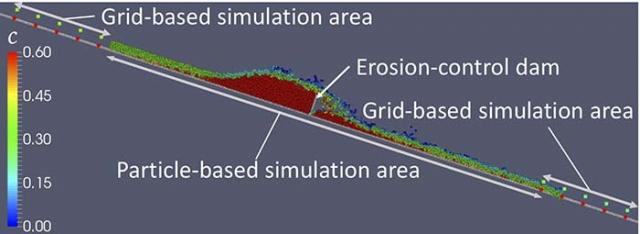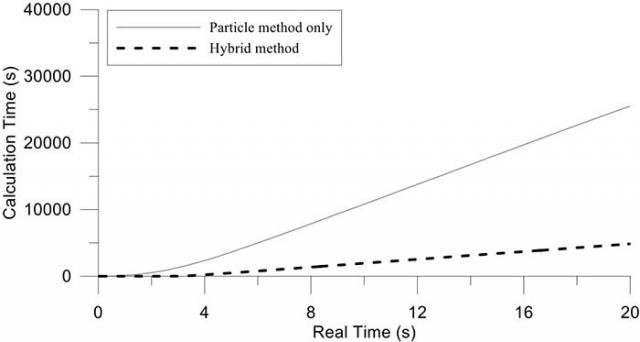Home > Research > Research Results > Research Results 2018 > Achieving high-precision debris flow simulations in a short period of time
Update:September 14, 2018
Main content starts here.
Achieving high-precision debris flow simulations in a short period of time
| Article title |
Coupling of particle and grid-based methods for debris flow simulation |
|---|---|
| Author (affiliation) |
Takuro Suzuki (a), Norifumi Hotta (b) (a) Department of Disaster Prevention, Meteorology and Hydrology, FFPRI, Tsukuba, Ibaraki, Japan. |
| Publication Journal |
Journal of the Japan Society of Erosion Control Engineering, 71(2):13-21, July 2018 |
| Content introduction |
Measures based on erosion-control facilities effectively prevent and reduce damage caused by debris flow. For such measures to be effective, technology that can recreate the movement of debris flow and consider the design and allocation of facilities is essential. An important means of achieving this is promoting studies related to sophistication in numerical simulation methods for debris flow. The previous simulation method, known as grid-based simulation, was a method for partitioning spaces where debris flow occurs in a calculation grid (mesh); however, the calculation precision near erosion-control facilities in this method was insufficient. Therefore, we previously developed a debris flow numerical simulation method known as particle-based simulation for considering fluid and ground facilities as groups of particles in the calculation. Although this method enabled us to calculate the behavior of complex debris flow in erosion-control facilities with high precision, the required calculation time was extremely long as compared to that of the previous grid-based simulation. Furthermore, calculating the whole series of processes from the source of the debris flow until it is captured in the erosion-control dam was deemed unrealistic. Therefore, to utilize the benefits of both particle-based simulation and grid-based simulation, we developed a new hybrid method in which only those areas that require high-precision calculation—such as the areas surrounding erosion-control facilities—are calculated using particle-based simulation, while grid-based simulation is used for the other areas to reduce the calculation time. We verified this hybrid method, and it enabled us to retain calculation accuracy for the required areas, while greatly reducing the overall calculation time. For example, if the area for particle-based simulation calculation under fixed incline conditions is limited to 1/5, the calculation time is approximately 1/5. Therefore, as this method enables a wide variety of calculations in various locations, it is considered important for studying the efficient design and allocation of erosion-control facilities.
Figure 2. This diagram compares the calculation time under fixed incline conditions, when limiting the particle-based simulation calculation period to 1/5 (hybrid method) and when calculating the whole area using particle-based simulation. The hybrid method calculation time is approximately 1/5th the calculation time when using the particle-based simulation exclusively. |
Copyright © Forest Research and Management Organization. All rights reserved.


